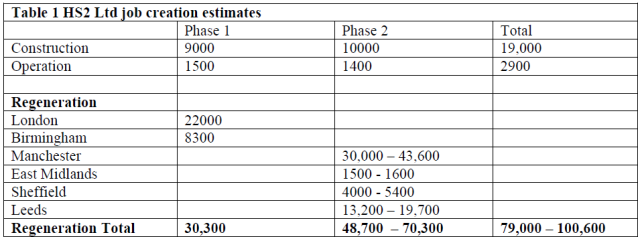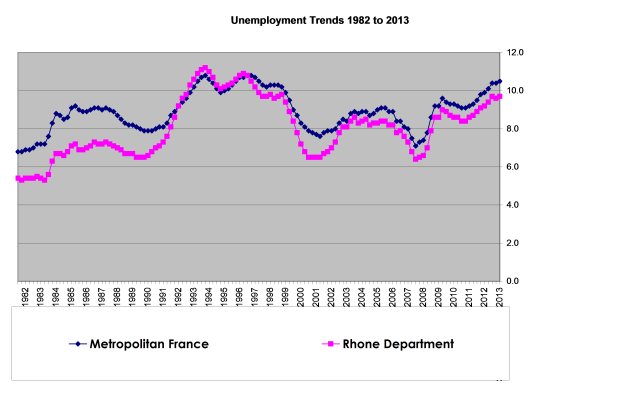Ever since Transport Secretary Philip Hammond claimed that linking England’s main cities via high speed rail could help break down the north-south divide., the government and supporters of HS2 have consistently claimed that HS2 will have a transformational impact of this kind.
The HS2 Growth Taskforce says that “HS2 could be much more than a railway. It could be an exciting and transformational opportunity, particularly for our cities in the Midlands and North….HS2 can help rebalance the economy.”
Such claims have however been challenged just as consistently by independent experts:
‘‘Taking the evidence in the round it is very difficult to substantiate the argument that high speed rail is likely to have a positive impact on regional inequalities.’
Professor John Tomaney, University College London
‘In most developed economies high-speed railways fail to bridge regional divides and sometimes exacerbate them. Better connections strengthen the advantages of a rich city at the network’s hub: firms in wealthy regions can reach a bigger area, harming the prospects of poorer places.’ The Economist
What is the current evidence as to whether the employment impact of HS2 would significantly reduce the North-South divide?
HS2 and job creation: Recent evidence
The job creation impact of HS2 falls into two parts: job creation from regeneration schemes linked to the construction of HS2, concentrated around stations, and that arising from the wider impact of HS2 on the economy.
Jobs from regeneration
Current government estimates of job creation directly associated with HS2 are as follows (1) :
 Of these the construction jobs are temporary, and the operational jobs are small in number. The regeneration-related employment estimates are more significant, and the vast majority of these would be around stations in the Midlands and North.
Of these the construction jobs are temporary, and the operational jobs are small in number. The regeneration-related employment estimates are more significant, and the vast majority of these would be around stations in the Midlands and North.
However, as the government admits, many of these will not actually be new jobs, but relocations from elsewhere. Moreover, they are not necessarily directly attributable to HS2: while their location is a direct consequence of the location of HS2 stations, they will depend heavily on other public and private regeneration investment.
Wider employment benefits
In addition to possible job creation through HS2 station-related regeneration, it is argued that there will be ‘wider economic benefits’ in terms of growth and jobs.
There are two main recent sources of evidence for the wider economic benefits accruing from HS2.
The 2013 report by KPMG, HS2: Regional economic impacts, claims that HS2 could generate £15bn productivity gains for the GB economy in 2037 when the full Y network opens, with a further positive effect in following years. However the employment implications of this are not spelled out by KPMG (and it is of course quite possible that productivity gains would not translate into employment growth).
Moreover, the methodology utilised by KPMG has been severely criticised by independent experts. Professor Henry Overman of the LSE, erstwhile adviser to HS2 Ltd, in a commentary titled ‘HS2 Regional Economic Impact: Garbage in……?’, says the report does things which are ‘technically wrong’ but are crucial for their findings. Key parts of their methodology ‘does not have a firm statistical foundation’, ‘is essentially unfounded’ and ‘produces estimates of effects that are meaningless’.
KPMG also make clear that the economic impact of HS2 would produce losers as well as winners, especially in places and regions distant from HS2 stations. These need to be set against the headline-catching ‘£15bn gains’.
Estimates of wider potential regional employment impacts have also been made for the HS2 Growth Taskforce (2). Table 2 combines these with the station-related jobs to show the total jobs claims for station-related regeneration and wider economic impact (henceforth the ‘official estimates’).
 If this data is taken at face value, it suggests that HS2 would have some impact on the north-south employment divide. The estimate for London is greater than that for any other region/city, confirming that London would be the biggest beneficiary of HS2, but it is between 66,500 and 43,000 lower than that for the whole of the Midlands and North.
If this data is taken at face value, it suggests that HS2 would have some impact on the north-south employment divide. The estimate for London is greater than that for any other region/city, confirming that London would be the biggest beneficiary of HS2, but it is between 66,500 and 43,000 lower than that for the whole of the Midlands and North.
Problems with the official data
The official estimates cannot however be taken at face value, for a number of reasons:
• The estimates of job creation for the Growth Taskforce are not independent. They come from organisations with vested interests, such as Centro in the West Midlands, for whom this is a possible opportunity to lever in major further packages of regional transport investment, and thus are of questionable credibility.
• The estimates are dependent on these very substantial additional regional transport investment packages. If these are seen as jobs created by HS2, this effectively massively increases the cost of HS2. On the other hand if these costs are not incorporated in the bill for HS2, neither can HS2 justifiably claim these ‘wider economic impact’ jobs, which are only tangentially dependent on it.
• Moreover, there is no new government money for the regeneration proposed and so money would have to be taken from existing funds, threatening other regeneration possibilities across the region. Effectively, a big slice of future regional transport investment and regeneration would be diverted to try to support HS2 rather than to meet local needs.
• In addition, the intention of the Growth Taskforce is to show how the supposed growth and jobs benefits of HS2 can be more widely spread, by means of city-region regeneration and transport strategies centred around HS2 stations. But this means that the primary beneficiaries would be the core cities in each region, creating new disparities between the big cities and other areas. Thus for example of 51,000 jobs in the West Midlands half would be in Birmingham and Solihull, with the rest of the region fighting over the scraps.
• Much more account needs to be taken of jobs lost due to HS2. These are largely excluded from consideration by HS2 Ltd, but would be substantial. They include jobs destroyed in businesses directly impacted by HS2, and others such as jobs lost in train operating companies which lose business to HS2.
• The cost of each job created by HS2 would be eye-wateringly expensive. Taking the jobs in Table 1 (as these are the only ones for which costs are available), would, on the basis of government figures, each cost somewhere between £420,000 and £350,000. The real figure would be much higher if temporary and relocated jobs were excluded. Applying the average cost per job in the wider economy to the sum which HS2 will cost would create 4 times as many jobs, while the cost per job for a standard local economic regeneration project is probably around £35,000. There are much better ways of spending the money allocated to HS2 which would bring more jobs and growth across the whole country (3).
• Finally, these estimates of the job creation potential of HS2 are far below earlier estimates which were crucial in building the case for HS2 in the Midlands and North. Probably the most widely cited source of this type was undertaken for Greengauge 21 by KPMG in 2010 (4) . This showed gains by Northern and Midland regions (with the exception of the East Midlands) but also – in contrast to the contemporary official estimates – substantial losses in the Southern regions. Political and policy support for HS2 was thus built initially on claims that HS2 would have a far more substantial impact in narrowing the North-South divide than current estimates.
HS2 jobs claims in context
Even if we were to ignore these many awkward questions about the official jobs claims for HS2, to what extent would they reduce the North-South employment gap? Asking this question highlights an important absence from the much of the debate about the impact of HS2 on North-South employment disparities: to wit, any benchmark of the scale of existing regional disparities against which to measure claimed impacts of HS2.
There is not a benchmark which is directly comparable to the official data. A comparison can be made however which still offers a valuable contribution to policy debate.
An authoritative independent forecast of employment change by region over the next decade indicates employment growth in all regions, but much greater in the Southern regions than those of the Midlands and North . The North-South divide is projected to widen significantly, by about 380,000 jobs or about 35,000 a year (5).
How does this compare with the current official claims? We cannot be precise, as the latter are for an unclearly specified future period, while the regional employment forecasts are for the next decade. All the same, a comparison provides very illuminating orders of magnitude. The official HS2 jobs claims show a narrowing of the North-South divide by 43-66,500 jobs. If we were to assume that these occurred over a decade, that would mean roughly 4,300 – 6,600 jobs a year – compared to the 35,000 a year by which the regional employment forecasts suggest the divide is currently widening. The impact of HS2 – even ignoring all the deficiencies of the official estimates noted above – would not come anywhere near stemming the current widening of the jobs divide, let alone start to close it. This fundamentally questions any statement that HS2 could bring ‘transformational change’ to the economic geography of the UK.
Conclusions
Assertions that employment growth attributable to HS2 will significantly reduce the North-South employment divide are unsustainable:
• Official forecasts of the regional employment implications of HS2 produced by government or by supporters of the project are subject to very serious omissions and qualifications.
• Even so, they are much more modest than previous estimates which were crucial in building the case for HS2 in the North and Midlands.
• Even when the official claims are taken at face value, any reduction in the jobs gap would fail by a large margin to stop the North-South divide widening, let alone produce ‘transformational change’.
• The jobs created by HS2 and possible associated investment would be primarily concentrated in the core city regions, especially around HS2 stations, creating new disparities within regions.
• HS2 is a very wasteful means of job creation. The £43bn cost of the scheme could be used much more cost effectively to create many more jobs across the whole country.
Footnotes
1. http://www.hs2.org.uk/what-hs2/economic-benefits-jobs
2. Atkins, Maximising the Growth and Regeneration Benefits of HS2: Final Report, March 2014. It should be noted that the data varies region by region in terms of its origin and geographical coverage.
3. See for example New Economics Foundation, High Speed 2: The best we can do? June 2013
4. KPMG, High Speed Rail in Britain: Consequences for Employment and Economic Growth. Greengauge 21, 2010
5. Cambridge Econometrics, Economic Prospects for the Nations and Regions of the UK, January 2014.




